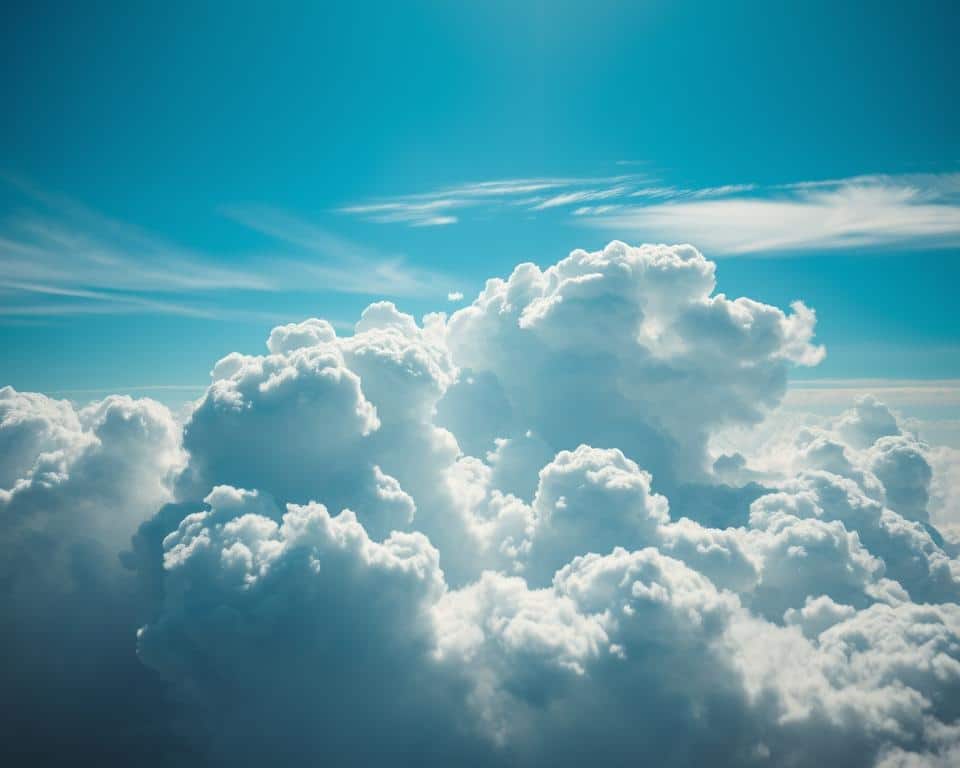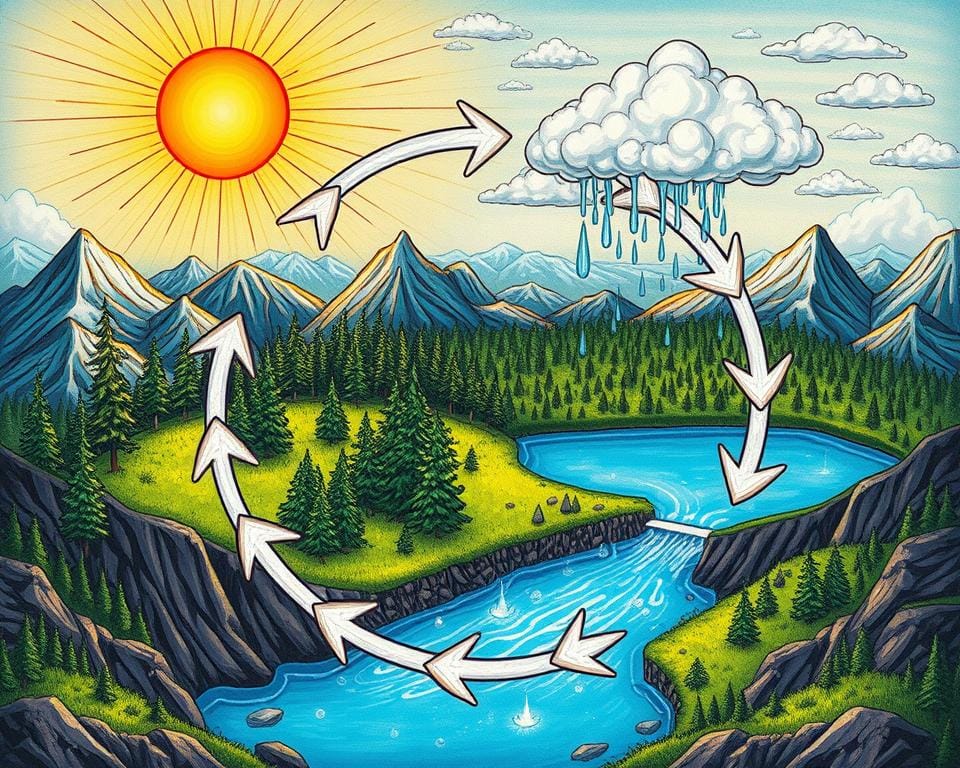The water cycle, known as the hydrologic cycle, is a wonderful journey of water on Earth. It includes steps like evaporation, transpiration (creating evapotranspiration), condensation, precipitation, and runoff. These processes work together to keep water moving in the hydrosphere. This movement ensures that moisture in the air stays balanced and ecosystems thrive.
Evaporation starts the cycle, powered by the sun, turning water from liquid to vapor. It adds a lot to the moisture in the air. This cycle is key for spreading and keeping water around. It also helps with ecological balance and affects the weather. Knowing these stages helps us understand how Earth’s climate works. It also shows why we need to protect our water sources.
Stay tuned as we take a closer look at every stage of the water cycle. We’ll explore how each one is unique and why they are so important for our environment.
Evaporation: The Beginning of the Water Cycle Journey
Evaporation is the start of the water cycle. It turns water from liquid to gas form. The sun’s energy is vital for this, breaking water molecule bonds. This lets them move into the air as vapor.

Definition of Evaporation
Evaporation is when liquid water becomes gas. It happens when water gets enough energy to leave surfaces and enter the air. It’s not just in big oceans but includes plant transpiration and snow sublimation too. These combined actions are called evapotranspiration, key to the water cycle.
Factors Affecting Evaporation
Several factors influence how fast water evaporates:
- Temperature: Warmer temperatures help water molecules become gas faster.
- Humidity: Evaporation speeds up when the air is drier, as it can take more vapor.
- Wind Speed: Wind moves humid air away, bringing in drier air that boosts evaporation.
- Solar Radiation: The sun’s heat is crucial for warming water and aiding evaporation.
The Importance of Evaporation in the Water Cycle
Evaporation is a cornerstone of the water cycle. It’s a major way water vapor gets into the atmosphere. This vapor forms clouds and rains down, refilling Earth’s water. So, evaporation helps keep our climate stable and ensures we have fresh water.
Learning about transpiration, sublimation, and solar radiation helps us grasp evaporation’s full impact. Together, they balance water in nature, supporting all life.
Condensation: Transforming Water Vapor Back into Liquid
Condensation plays a key role in the water cycle by turning water vapor into liquid. This happens when air fills with moisture, leading to cloud making. It is key in understanding weather and climate change.

How Condensation Occurs
Warm, moist air rises, then cools, reaching its dew point. This cooling makes water droplets form. These droplets become clouds or turn into dew and frost on surfaces. The U.S. Geological Survey has more on this.
The Role of Temperature and Air Pressure
Temperature and air pressure are vital to condensation. As air goes up, it cools because of less pressure. This cooling accelerates water vapor turning into liquid, a fact proven by experiments. Mixing air masses with different temperatures and pressures also helps, creating clouds and changing weather.
Impacts of Condensation on Weather and Climate
Condensation greatly affects our climate. It decides how much moisture is in the air, forms precipitation, and leads to fog, dew, and frost. These effects are crucial for ecosystems and change the water cycle. They influence everything from what we see in the weather to global climate trends.
For more on how condensation ties to water filtering, check out this guide on water softeners and filtration systems.
Understanding Water Cycle Stages: Evaporation, Condensation, Precipitation, and Runoff
The water cycle includes four main stages: evaporation, condensation, precipitation, and runoff. Each one is key in keeping our environment in balance. Evaporation happens when the Sun’s heat turns water from liquid to vapor. This is shown in water cycle diagrams. It helps control temperature and cleans the water.
Then, condensation turns water vapor back into liquid, forming clouds. This is crucial for creating weather patterns and managing the Earth’s climate. Precipitation is when water comes back to the ground as rain or snow. It gives water to plants, fills up our wells, and keeps ecosystems alive.
Runoff happens when the ground can’t take in all the water, making it flow to rivers and seas. It’s important because it keeps our water supplies balanced. Human activities and nature can change how runoff works, which can lead to soil being washed away. Knowing about the water cycle helps us look after the environment and plan our cities.
Groundwater flow is also crucial. It’s water moving underground, where it can be a major source of drinking water and help ecosystems. Water gets into the ground, and sometimes joins with groundwater. This keeps ecosystems balanced and working right.
| Process | Description | Importance |
|---|---|---|
| Evaporation | Water transforms from liquid to vapor. | Regulates temperature and purifies water. |
| Condensation | Vapor cools and forms clouds. | Crucial for weather development. |
| Precipitation | Water returns to Earth as rain, snow, etc. | Nourishes plants and refills aquifers. |
| Runoff | Water flows over land into bodies of water. | Maintains water balance in reservoirs. |
| Groundwater Flow | Movement of water through aquifers. | Supports drinking water and ecosystems. |
Learning about the water cycle through diagrams and hydrographs shows the big picture of groundwater flow. It tells us how each stage matters. This information helps us figure out how to solve environmental problems. It also helps us make sure our ecosystems stay healthy.
Precipitation: Bringing Water Back to Earth’s Surface
Precipitation plays a key role in the water cycle. It brings water back to Earth from the atmosphere. You’ll see it as rain, snow, or hail. It’s a big part of the water cycle precipitation. The process starts around cloud condensation nuclei, where water vapor gathers.
Precipitation is vital for giving Earth fresh water. It helps with infiltration, where water goes into the ground. And runoff, when water moves over the surface. These actions are crucial for moist soil, plant life, and our fresh water sources. Each type of precipitation, like gentle rain, soft snow, or hard hail, is important. They all help keep the water cycle going.
- Rain: It’s the most seen form, crucial for farms and our water supply.
- Snow: Important for keeping temperatures steady. It helps fill up aquifers when it melts.
- Hail: Shows severe storms. It affects nature and our man-made world in unique ways.
Learning about precipitation shows us the beauty of natural Earth processes. It gives us water to drink and helps plants grow. Every raindrop plays a part in making Earth livable. So whenever you’re caught in rain, watching snow fall, or dodging hail, think about its role. It’s all about keeping the water cycle precipitation moving, with cloud condensation nuclei at its heart.
Conclusion
Looking at the water cycle’s journey shows its vital role in our world. The stages—evaporation, condensation, precipitation, and runoff—keep nature in balance. They ensure we have fresh water across the globe.
Evaporation starts with the sun heating water bodies, turning water into vapor. This vapor rises, cools down, and forms clouds. Those clouds then move across the sky.
When clouds fill with water, we get precipitation. Rain and snow fall back to Earth. This process refills our rivers, lakes, and underground water. It’s key for our drinking water and nature’s ecosystems. Runoff then takes extra water across the land. It flows into streams and rivers, ending up in larger water bodies. This cycle keeps everything in harmony.
Understanding this cycle shows why we must save and wisely use water. The cycle helps farming, keeps animals thriving, and even shapes our weather. Want to learn more about saving water? Check out this article. Knowing about the water cycle helps us plan for our future. It lets us keep our planet’s most important resource safe for the next generations.

